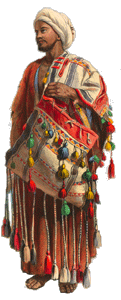Exhibition: “Fertile Nile Valley: Prisse d'Avennes's Lithographs of the Characters, the Costumes, and the Modes of Life”
 (Lithographs of Egyptian manners and customs in the 19th century) (Lithographs of Egyptian manners and customs in the 19th century)
The peoples of the Nile valley, sketched by Egyptologist Prisse d’Avennes
Egypt was legally a part of the Ottoman Empire during the first half of the 19th century, but de facto was an independent country ruled by Viceroy Muḥammad ʻAlī. It was 50 years before Japan's Meiji Restoration that Muḥammad ʻAlī aimed to create a rich country with a strong army, modeled on Europe; after spreading his rule to the holy cities Mecca and Medina across the Red Sea as well as to the Upper Nile lands of Nubia and Sudan, he finally gained the rule of Syria from the Ottoman Empire in the early 1830s. Under Muḥammad ʻAlī's rule, Egypt progressed towards modernization with a new conscription system and better infrastructure such as roads and canals. After 1840, owing to the strong European pressure, he withdrew his rule from all the other regions except Egypt, Nubia, and Sudan.
This exhibition showcases 30 chromolithographs created by the French Egyptologist Émille Prisse d'Avennes (1807-1879), who visited the Nile valley, including Ethiopia, during this period. Prisse d'Avennes traveled to Egypt in 1827 and completed many rough sketches in various local areas during 1841-1844. The Research Institute for Languages and Cultures of Asia and Africa is the only institute that owns the “Oriental Album,” which was published in London in 1848. At this exhibition, visitors will be able to see digitally restored reproductions that closely resemble the original lithographs. Many of the pieces are portraits of peoples from various classes. They are all visual materials with much value concerning styles of living in the Nile valley during the early 19th century, and demonstrate vividly the manner and customs of that time in a way that cannot be described by literary documents.
This is the second exhibition that shows the manners and customs of the Islamic world in the early 1840s, since our well-accepted exhibition in 2007, “Splendid Afghanistan 1848: James Rattary's Lithographs of the Costumes and the Scenery.”
|
